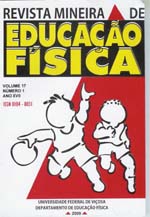BASKETBALL FUNDAMENTALS EMPHASIZING THE JUMP
Keywords:
shooting, jump, basketballAbstract
The shooting is the most important fundamental in basketball, because it is through it that points are obtained in the game. This is a bibliographic study which aimed to analyze the basketball fundamentals, demonstrating their importance in the basketball game, emphasizing the jump as the most used in the sport. Studies from 1988 to 2010 were analyzed in national and international publications from sources: BIREME, MEDLINE, LILACS and SciELO. As a result, it was found that the Jump shot is the most complex fundamental in the sport of basketball; in this sport, to achieve prominence as an athlete, it is necessary the creation of new gestures, seeking resolutions to the problems presented at the game time. It is concluded that basketball is not the sum of its fundamentals and/or knowing the best way of passing, shooting, dribbling or grabbing a rebound, while important, does not guarantee playing well because, due to its complexity, it requires combine and multiply skills for achieving a high level of performance.
Downloads
References
CONFEDERAÇÃO BRASILEIRA DE BASKETBALL. Disponível em: <www.cbb.com.br/conheca_basquete/hist_oficial.asp>. Acesso em: 21 mai. 2012.
CONFEDERAÇÃO BRASILEIRA DE BASKETBALL. Regras oficiais de basquetebol. Rio de Janeiro: Sprint, 2011.
COSTA, C. P. Estudo sobre modelos de desenvolvimento de federações desportivas no Estado do Pará – Brasil. Tese (Doutorado) – Faculdade de Desporto da Universidade do Porto, 2010.
COUTINHO, N. F. Basquetebol na escola. 3. ed. Rio de Janeiro: Sprint, 2007.
DAIUTO, M. Basquetebol: origem e evolução. São Paulo: Editora Iglu, 1991.
DANGELO, J. G.; FATTINI, C. A. Anatomia humana sistêmica e segmentar. São Paulo: Editora Atheneu, 2007.
DE ROSE J. D.; TAVARES, A.C.; GITTI, V. Perfil técnico de jogadores brasileiros de basquetebol: relação entre os indicadores de jogo e posições específicas. Rev. bras. Educ. Fís. Esp., São Paulo, v.18, n. 4, dez. 2004
DE ROSE, J. D.; TRICOLI,V. Basquetebol: uma visão integrada entre ciência e prática: Barueri: Manole, 2005.
FERREIRA, A. E. X.; DE ROSE, D. J. Basquetebol: técnicas e táticas: uma abordagem didático-pedagógica. 2. ed. ampliada e atualizada. São Paulo: EPU, 2010.
FILHO, A.O. A História do basquete de rua. 2006. Disponível em: <http://www.lub.org.br/lub/wp-content/uploads/2011/06/Hist%C3%B3ria-do-Streetball-3.pdf>. Acesso em: 30 julho 2012.
GRAY, H. Anatomia. 29. ed. Rio de Janeiro: Guanabara Koogan, 1988.
MARQUES, W.C. Técnico didático de basquetebol. Brasília: Ministério da Educação e Cultura, Secretaria da Educação Física e Desportos, Departamento de Documentação e Divulgação de Brasília – DF, 1980.
MAYER, M. Fatores motivacionais de atletas infanto-juvenis para a prática do basquetebol. Monografia. Novo Hamburgo, 2010.
OKAZAKI, V.H.A. RODACKI, A.L.F.; OKAZAKI, F.H.A. Arremesso tipo jump no basquetebol: novatos versus experientes. Revista Mackenzie de Educação Física e Esporte, v. 5, n. 2, p. 33-39, 2006.
OKAZAKI, V.H.A.; RODACKI, A.L.F. Changes in basketball shooting coordination in children performing with different balls. Fédération Internationale D'éducation Physique, v. 75, n. 2, p. 368-371, 2005.
OKAZAKI, V.H.A; RODACKI, A.L.F.; SARRAF, T.A.; DEZAN, V.H.; OKAZAKI, F.H. Diagnóstico da especificidade técnica dos jogadores de basquetebol. Revista Brasileira de Ciência e Movimento, v. 12, n. 4, p. 19-24, 2004.
PAES, R.R.; MONTAGNER, P.C.; FERREIRA, H.B. 1956 – Pedagogia do esporte: iniciação e treinamento em basquetebol. Rio de Janeiro: Guanabara Koogan, 2009.
PARENTE, A,T.; FIUZA, T.S. Disponível em: <http://www.sbpcnet.org.br/livro/63ra/conpeex/extensao-cultura/trabalhos-extensao-cultura/extensao-cultura-athos-tollstadius.pdf>.
PUTNAN, C.A. A segment interaction analysis of proximo-to-distal sequential segment motion patterns. Medicine and Science in Sports and Exercise, v. 23, n. 1, p. 130-144, 1991.
RODACKI, A.L.F.; FOWLER, N. E.; BENNET, S.J. Multi-segment coordination: fatigue effects. Medicine and Science in Sports and Exercise, v. 33, n. 7, 2001b.
RONDELLI, P. História e regras – Brasil Escola. 2009. Disponível em: <www. brasilescola.com/educacaofisica/basquetebol.htm.>Acesso em: 21 mai. 2012.
RUDIK, P.A. Fundamentos psicológicos de la enseñanza y elperfeccionamento em el deporte. Moscou: Planeta, 1990.
Downloads
Published
How to Cite
Issue
Section
License
Os artigos submetidos e publicados são de inteira responsabilidade de seus autores, não refletindo necessariamente a opinião do Comitê Editorial. A revista se reserva o direito de efetuar, nos originais, alterações de ordem normativa, ortográfica e gramatical, com vistas a manter o padrão culto da língua, respeitando, porém, o estilo dos autores. O manuscrito submetido deve ser original, não podendo ter sido publicado em qualquer outro veículo de informação científica, e nem submetido para publicação em outra revista científica. Os trabalhos publicados passam a ser propriedade da revista Mineira de Educação Física, ficando sua reimpressão total ou parcial de acordo com a licença Creative Commons Attibution 4.0. Deve ser consignada a fonte de publicação original. Os originais não serão devolvidos aos autores. As opiniões emitidas pelos autores dos artigos são de sua exclusiva responsabilidade.





 Esta obra está licenciada com uma Licença
Esta obra está licenciada com uma Licença 